Early in his biographical novel The Journey of Anders Sparrman, Per Wästberg describes the two family homes in which the young Sparrman grew up in Sweden. Born in 1748, he would become an important follower of the great inventor of the Linnaean system of natural classification Carl von Linné, parts of whose approach are still in use today. Sparrman would serve as naturalist on Cook's second voyage. But that was still many years away, and my emphasis here — the vexed question of authenticity, and how we shall know it — falls on the buildings in which he lived. I quote from Wästberg's account:
Lena Rectory, where Anders Sparrman spent his early years, was built in 1728 using thirteen layers of logs on stone foundations, with a roof of bark and turf, and two chimneys. A living room in the centre, two bedrooms on the east side and a kitchen on the west, plus a porch. A living-room door with a lock and key; two windows of twenty panes each; a stove and damper ... Further away from the house stood a barn with a corn store, as well as a tool shed, straw shed, cow shed, pigsty, and a shed for sheep with its own hayloft. The bath-house also contained the malt-house and drying-room, and spices and hemp were kept in its gable loft ... The meadow produced forty cartloads of hay ...The church at Lena stands on a ridge above the valley where the River Vendel joins the Fyris. The walls are yellow-plastered with white corners, the roof is of tarred shingles, and it was built around 1300 in a region which was converted to Christianity in the eleventh century. The weathercock is perched on a globe. The parish hall from Anders Sparrman's time is still there.
The thirteenth-century church at Tensta [the Sparrmans' second family home] is situated at the point where the Uppland plain meets the northern forests of the province. It has a huge seventeenth-century key, which is still in use.[1]
Wästberg's wonderfully fresh narrative draws mainly on Sparrman's own journals and published letters. What we gradually appreciate is Wästberg's habit of attention to historical sources and his use of acute physical observation that together give us, as in this passage, such telling details as the 40 cartloads of hay, the weathercock perched on the globe, and the ancient key that is still in use. The deliberate shift from the past to the present tense as the church at Lena is described alerts us to an essential continuity from the time of Sparrman's clergyman father, once rector at Lena, to our own, in the reading present. What might be called an authenticity effect is engendered by this rhetoric of historical, almost editorial precision. In the medium of the printed word, that is enough; if we decide to go along for the ride it is with the confidence that this author pays attention, and can write.
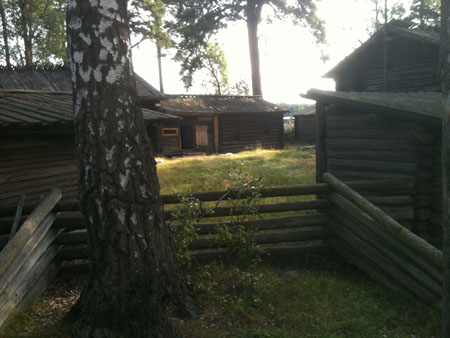
The visitor today gets a sense of building styles gradually unfolding as new techniques entered the building lexicon. Log construction continued throughout the period covered in the museum from the seventeenth century. (Very little wooden construction survives in Finland from before then.) The much older, prehistoric style of circular construction of cone-shaped huts, with a central hearth, persisted until the early twentieth century, but only for the special-purpose functions of the laundry and the sauna. The gradual change from windowless log cabins to the use of small panes of glass (very expensive until about 1750 when local manufacture commenced) and of flued chimneys rather than the chimneyless 'smoke houses', which Finnish peasants found warmer and more familiar until well into the nineteenth century, is amply represented. These houses with their smoke-blackened ceilings are very dark. The gentry adopted chimneys earlier and whitewashed their interior walls. But, oddly for houses whose log construction is everywhere evident and cannot be concealed, they embraced delicate classicising decoration and furnishings in the eighteenth century; these houses allow in far more light.
As time went by the farmhouses grew in size, adding a guest room and one or two bedrooms. Three or four family members would typically sleep in the same narrow bed. The main room was where food was prepared and then eaten on a long table, and where the men in winter occupied one side of the room, carving and repairing their tools for spring, and the women occupied the other, sewing and embroidering. A farm typically had many other buildings, each devoted to its special function — in Sweden too, just as Wästberg points out.
Vernacular buildings constructed without formal plans tend, functionally and structurally, to embrace what has already proven itself, usually with some adaptation. They are in this sense folkloric,[2] whereas buildings that materialise a documented architectural intention ask to be read within the domain of aesthetics. Such buildings, which usually aim to solve a design problem with some measure of originality, can be considered as works. But works and what in fact works over time are two different things. Documenting the latter more socialised achievement is the special realm of the open-air folk culture museum.
On a breezy island as it is, Seurasaari feels remote from Helsinki, and one wanders through a natural forest from building to building. To observe the folkloric evolution in building styles and the changing social patterns that they index, in such a concentrated form, almost exhibit by exhibit, can be an intriguing experience.
Nevertheless a qualm about the status — the reality — of what one is seeing is wont to arise as when, for instance, outside the reconstructed church one comes across a sample couple of gravestones surrounded by ornamental iron railings. This exhibit is intended to represent the graveyard and the remains, which, of course, had to be left behind at the original site. This graveyard exhibit does not interrupt the scrupulous representation until, on the other side of the church path, one sees an obviously modern memorial to the founder of Seurasaari who, it turns out, is actually buried here. His remains are below this ground. A slippery dividing line between presentation (of the real thing) and representation (of the relocated) becomes visible and is crossed at moments like this. The question arises: is this kind of slippage always there? Is it the unavoidable curse of museums, even in museums like this one, without walls, which at first strike the visitor as anything but museum-like?
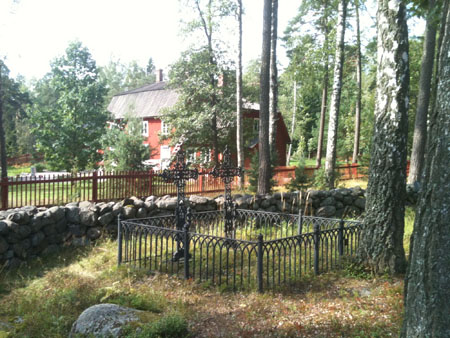
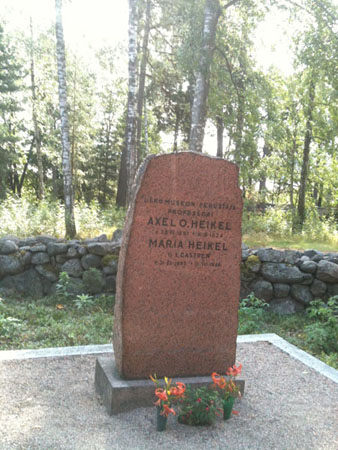
The impulse behind the urge to preserve and collect at Seurasaari came in part from the wave of nationalism that grew in the period between Finland's separation from Sweden in 1809 following its lost war with Russia, and 1917, when Russia, in the midst of its own revolution and in no position to do anything about it, tolerated the Finnish legislature's declaration of Finland's status as an independent country. There were ructions within Finland after this declaration, but the country's independence was in due course confirmed. One of the buildings at Seurasaari is the writing cabin of their most famous novelist Alexis Kivi, whose Seven Brothers (1870) is the first significant novel written in Finnish and one of the defining documents of the new sense of national identity, one which the late Romanticism of Sibelius (1865–1957) would famously deepen through his music until the mid-1920s.
Seurasaari springs out of a late nineteenth-century cherishing of a Finnish folk culture, felt to be in danger of being overwhelmed as manufactured tools, clothing and building materials began to displace the old folk traditions. Nor was this impulse peculiar to Finland. Its broader contexts include the international, late-nineteenth-century Arts and Crafts movement that flourished into the early twentieth century, and the dedicated contemporaneous collection of folk tales and folk music, all of which were feared to be in danger of being lost.[3]
Such anxieties underlay the creation of the Norsk Folkemuseum, founded in 1894 by Hans Aall. He was determined to collect and preserve the artefacts and dress of common, everyday life. In 1907 the small collection of buildings of King Oscar II of Sweden and Norway, which he had opened to the public in 1882 (including a stave church, c. 1200, relocated from Gol in 1884), was incorporated into the museum. The two collections were located next to one another at Bygdøy, now a suburb of Oslo but then a summer retreat. This was again part of a larger cultural movement of national self-definition in which literature, theatre, painting and music played their parts — including that of Edvard Grieg, of whom more, below.
By 1900 the area around the stave church at Bygdøy had become a popular excursion destination; today, weddings in traditional regional dress are held there. The reconstruction of the stave church followed the model of another one at Borgund. The official guidebook states that 'Most of the central construction was intact, and from these parts it was possible to infer the vital information needed for completing the reconstruction.'[4] (The term stave refers to the lofty central pillars — tree trunks — that support the church, giving it an appearance of extreme verticality. Its successive roofs have an oddly Chinese-temple-like appearance, but the origin of the style is unknown. The painting of the choir walls and those of the apse date to the 1650s, during the church's Lutheran period.) After the church, the suggested route moves you onward toward successive sets of farming buildings.
Because the site is open-air; because you walk in the very extensive grounds, encountering farmstead after farmstead; because you walk in and around and through them; and because you encounter them in relation to your own physical space rather than behind glass cabinets, you are continually tempted to think of them as something other than type-specimens. You are tempted to think of them as the real thing, an intuition that the explanatory guides and labelling do little to dispel:
In the section of the Open-Air Museum featuring rural Norway, visitors can walk from one imaginary district of Norway to the next, and thus get a sense of most of the country in one day. The farmsteads are organized according to geographic regions, and the buildings are placed according to traditional farms of their region. To complete the picture of rural Norway in the 18th and 19th century, staff members in historic dress perform farm work and traditional household chores during the summer season.[5]
There is a change in the museum rhetoric (if I may call it that) in the more recently curated city buildings in the Old Town. (This is the next section, established from 1915 upon the extensive renewal of Christiania, the old name of Oslo.) There, a relocated three-storey apartment building from 1865 contains self-consciously curated displays: rooms from the 1930s, 1950s, 1960s, a Pakistani immigrant family interior, etc. Here, a museum-logic is straightforwardly insisted upon, and you are generally separated from the displays by glass. Reflecting back upon the farm buildings areas (the bulk of the site), which you have just walked through, the awareness grows that the farm buildings are only a collection in a museum. This should not be disconcerting or diminishing. This whole site is a museum and claims to be nothing other. Yet it remains disconcerting.
You had wanted to play along, and you were learning as you wandered through the farmsteads. But finally you can't play along. As you scale back the claims that can realistically be made for this extraordinary effort at cultural preservation, you are forced back into the defensive position of reciting the ways in which this is not a Disneyland Norway (since that is your growing fear): that the building materials and their contents are, as far as possible, original; that original building techniques have been employed; that some contents have provenance to the original buildings; that much research has gone into the reconstructions and documentation.
But finally it becomes impossible to deny that this is an attempt to put Norway in a nutshell. The nutshell is the museum. That is the source of the (irrational?) disappointment you feel: that this is only a museum, that the buildings are merely curated material objects. Relocation has stripped them of an authenticity such as every visitor yearns for — is half promised — but can never have. Historical re-enactments, cultural events in the grounds, and lectures to tour groups, are offered as a substitute. But they merely exacerbate the existential failure.
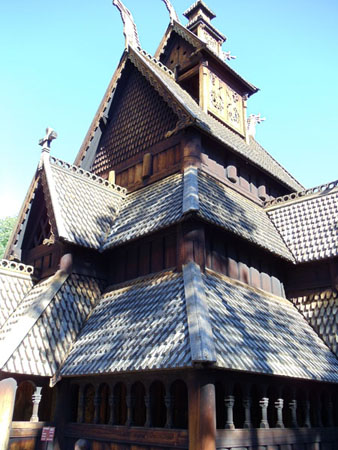
Is this too pessimistic a conclusion? Whether at Seurasaari or the Nordic Folk Museum the displacement of the historical in favour of consumption in the present — consumption of historic Finland or folk-culture Norway — is something you cannot long remain unaware of. How can you not see the safety and emergency signage, the seats for some special function casually piled in a corner, the toilet facilities, the restaurants, the essential maps and other interpretative pamphleteering about the things you must not miss, the visitors (like yourself) milling around, earnestly consulting those maps and pamphlets, and arguing with one another over where to go next? Yet no visitor talks about these or remembers them: have they not seen them? Do we so automatically filter out the present?
An example. At the old entrance to King Oscar's founding collection of buildings a temporary tent and small grandstand had been erected on the day I visited, shrouding the late nineteenth-century entrance portal from view. (It had itself been relocated from Palace Park where, in 1883, it had been used as the entrance to the Norwegian Arts and Industry Fair.) On another tack, students each year in summer attend the old relocated school dressed in period clothes. The historically dressed teacher (a real teacher, not a dummy or an actor) gets the glorious chance to instil real discipline into her charges, an opportunity that her present-day counterparts can only dream about. The buildings become a backdrop for a playlet that the willing actors make up as they go along. They play at being counterparts of themselves in the past.
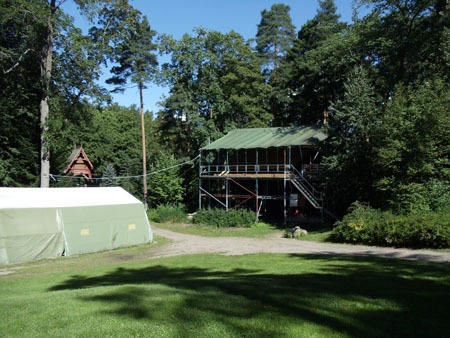
The route through the museum-park leads you, as I mentioned, through and out of rural Norway into the Old Town. On the day I was there, a young woman dressed in folk costume was selling boiled lollies in a shop in one of the many buildings in the town reconstruction of old Christiania. I sucked on one lolly, and then another. They reminded me of the boiled lollies my grandfather would occasionally buy for me when I was a small child in the 1950s. He bought them, I think, because they reminded him of one of the great but rare treats of his childhood in the 1890s. This curatorial strategy of invoking the dimly familiar memory went a step further with one of the traditionally dressed attendants looking after some workers cottages transferred to Bygdøy in the 1950s when a whole suburb of them was torn down. She poured me some coffee from an ancient kettle and offered me brown soda bread that she had just baked on the same wood-fired range that the modest dwelling had contained when removed here. With treacle or jam, and still warm, and because I was hungry, the bread was delicious.
I was literally a consumer, in the present. The point presumably was to overcome your sense of alienation from the past, to find the nearer way home — certainly via the stomach, also by way of the heart perhaps — to your historical imagination. Yet this young woman, a university student like all the rest — who were sitting, knitting or embroidering, and very happy to be photographed, doubtless as lending a tincture of picturesqueness — was clearly in good physical health. Her smile showed teeth in perfect condition. She was quite tall, had clearly never suffered from malnutrition or rickets or from most, if any, of the debilitating diseases that many of her predecessors would have suffered in these confined spaces, with their low-ceilinged cramped rooms, shared kitchens and beds, outside toilets without sewerage, and having nowhere to play but outside, even in the Nordic winter.
So again and again I found that my attention, in being directed at the past by the nature of the site and the cunningness of the curation, was carried back into the present. The extraordinary act of collection and preservation brought with it a troubling undercurrent of scepticism. What is the nature of the experience on offer?, I found myself asking. What is the experience an experience of? Another museum helped clarify the questions.
The National Museum in Prague, established in 1818, is situated in a grand classical-style building, magnificently decorated inside by an extensive use of marble and littered with bronze busts of the great and the worthy. It stands on a hill, and thus above, the main Wenceslas Square in Prague. Unlike the Enlightenment Gallery in the British Museum, it is, in the main, an unselfconscious monument to — an unironic presentation of — its own museological practices, dating back a century or more. Many of its very ample rooms are filled with glass-fronted wooden display cabinets organised along strictly classified lines. Sample after sample (whether mineral, stone or stuffed bird) — hundreds, thousands of them — aim, or were aimed, to fill out the whole geological or Linnaean picture. All specimens are neatly labelled with their scientific name and place of origin. It is an impressive embodiment of a mode of scientific knowing that derives from the eighteenth and especially the nineteenth centuries.
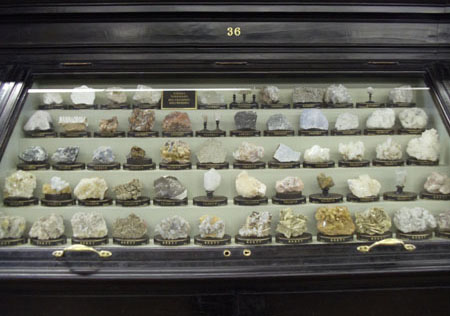
The mineralogical collection took my eye. The spirit of Professor Karel Vrba (1845–1922), who put it together, is surely linked at some level with that of Heikel and Aall.[6] The ideal in each case was to acquire types, as many different ones as possible, to ascertain their relationships through a system of classification and to present them, with utter integrity, so that they could be brought under the horizon of scientific knowledge. It is in this now very old-fashioned sense that the relocated farm buildings in Seurasaari and Oslo constitute a museum. So is my objection to them a genuine one?
Clearly it is better for typical examples of the regional domestic building styles to be preserved than to be allowed to decay till none is left at all. Once preserved, they can be studied from a variety of perspectives, both those we are aware of now and those not yet thought of. There is no substitute for one's physical presence within or around a building. Virtual reconstructions on screen can be helpful, but they are limited by their programming; and in any case I usually find myself attending more to their technological wizardry than to the real-world thing being virtualised. Ultimately, there is no getting over the fact that we live in bodies and that our bodies relate to the spaces in which we live, and in which our predecessors lived, so differently!
The extraordinary nature of the collecting in the two open-air museums, and the historical motivations that the collections embody, finally push one to recognise an existential gap. It lies between the buildings' apparently historical witness as material objects and their more subtle but more direct witness to the motivations of Heikel, Aall and their successors. The buildings' historical witness as material objects is not an untroubled one. The uncomplicated sense of authenticity possessed by historic buildings that have remained on their original site, and that have been subject to only slowly evolving adaptation to the needs of their users and inhabitants, is entirely absent at museum parks like Seurasaari and the Norskmuseum. In being so literally brought — physically, log by log — under the aegis of museological study and presentation their existential status has slipped, inevitably now, into the lesser realm of representation. No questions of agency or time can be asked of these relocated buildings, nor properly answered, without reference to the critical intervention of those who brought them here and who have displayed them.
This is because all acts of preservation and curation are agented and intentional. Curation strategies have designs upon us as we visit. Both activities operate according to the changing understandings embodied in their successive historical moments; and both are nowadays mostly guided by rigorous policies, ultimately reflecting UNESCO guidelines, about heritage sites, buildings and collections. These guidelines, supplemented by those of national professional associations, regulate activities in relation to the material objects (buildings, their furnishings and other collections), the use of original materials, minimal and readily apparent intervention in repair work and the making good of missing elements, the use as far as possible of original building techniques, and farming or gardening methods, and (for the open-air museums) respecting the original orientation of the buildings in a group to one another. The existential question that hangs over such reconstructed sites was neatly put in a comment by David Lowenthal in 1966, with Colonial Williamsburg in mind: '[T]he American past', he wrote, 'is not permitted to coexist with the present. It is always in quotation marks and fancy dress ... an isolated object of reverence and pleasure ... detached, remote, and essentially lifeless.'[7]
I was not prepared to go quite so far in my criticism of the open-air museums in Helsinki and Oslo. But on the train between Oslo and Bergen, on the west coast of Norway, I noticed on the alpine farms a few lofthouses of the same kind and built in roughly the same style as those I had just seen in the Norskmuseum — elevated barns used for storage (and originally for guests) in winter. On the farms there is no authenticity problem. Whenever these lofthouses were built they have continued a slowly changing folkloric tradition. They were evidently built because they could make use of a cheap local resource, because their building required inherited skills that were still available, and because they have continued to answer much the same needs on the farms as they always have.
Continuity seems to be the key, one that is definitively broken when such a building is acquired and relocated in open-air museums of the kind I have been describing. Existentially, something goes badly wrong. For historic buildings, place seems to be a primitive that precedes representation. The buildings emerge from their catastrophic dismantling into a new scientific objecthood of documentation, reconstruction and, by serving as representative building types, of ethnographic and other research. But principally nowadays the fate of such buildings that have lost their authenticity of place is to serve as the theatrical backdrop for historical dress-ups, tourism and picnicking — to become degraded objects of consumption.
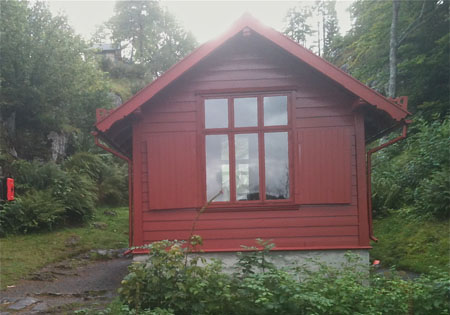
The Romantic and nationalist context for Grieg's compositions is well documented and it relates to those of the open-air museums: the publication of collections of Norwegian folktales in 1841 (Grieg was born in 1843) and 1853, and of mountain melodies the same year; a grammar of Norwegian dialect in 1848; JC Dahl's capturing of the Romantic sublime in his paintings of Norwegian mountains and valleys from the late 1840s; the foundation of Det Norske Theater (The Norwegian Theatre) by Ole Bull, a famous violinist, in Bergen in 1850; and Bjørnsterne Bjørnson's writing of what would become the Norwegian national anthem in 1859. Grieg's breakthrough works appeared from 1865, and his Twenty-five Norwegian Folk Songs and Dances in 1870. In 1884 he purchased the land for Troldhaugen, spending his summers in picturesque Norwegian valleys until he and his wife were able to move in. His Norwegian Peasant Dances, Op. 72 appeared in 1903. Percy Grainger, another collector and adapter of folksongs, visited him at Troldhaugen in 1907.
The Grieg house-museum is a Victorian villa, a combination of a traditional Norwegian cottage style using unpainted natural timbers but also reflecting contemporaneous European trends. It is filled with light from unusually large windows, with the result that the building was impossible to heat satisfactorily in winter. Grieg's own Steinway piano, on which he played immediately upon entering the house at the start of every summer, is there. Perhaps most poignantly, so is his writer's cabin, built in 1891 down by the lake. The cabin contained and still contains, placed on the chair on which he sat to play the piano, an edition of Beethoven's 32 sonatas. The volume was prized chiefly because of its thickness. A short man, Grieg needed the extra lift to sit properly at the piano. This detail, so eloquent in its material particularity, is only one example of many at this historic site. Nearly everything here has provenance.
But only the cabin and the downstairs rooms in the villa (itself a relatively small building) have been curated. This is often the case in such house-museums. Curation is very expensive. Sometimes the documentation as to the original contents is lacking, and even if available the compromise of acquiring contents that have no provenance cannot always be entered into in good conscience; and sometimes it is a matter of the damage likely to be caused by visitor access or by considerations such as staircases to upstairs areas failing to meet modern safety standards. In any case, at Troldhaugen the rest is closed lest the spell be dissipated. Interpretative museum displays have mostly been outhoused in a purpose-built museum that opened in 1995.
A concert hall was opened a decade earlier after the house itself was deemed too small for the demands of the annual Bergen music festival audiences. Grieg — or 'Grieg' at least — is unproblematically available during these concerts: we know the score, in both senses. We allow for adaptation and interpretation. It is in the nature of musical performance; it comes to life in front of us and in our heads and hearts as we listen. But that is true wherever performances occur.
The same reflection recurs with the Henrik Ibsen house-museum in Oslo, opened in 2006, the centenary of his death. It is the place where he spent his last years in relative affluence and where he wrote his final play, John Gabriel Borkmann (1896). New in 1895 when the Ibsens moved in, the apartment's original interior is mostly well documented by contemporary photographs. Three of the rooms have been curated with his reacquired furniture (and more has been promised), and with remanufactured wallpapers and wall furnishings of the original kind and pattern. His writing desk is there at the window overlooking the royal park and palace, and Ibsen's regular morning stroll to the Grand Café in the centre of town has been picked out in the pavements of the streets.
Some of the other rooms are occupied by interpretative displays, mostly biographical. They bring out, in the visitor, the inevitable awareness that the world-famous dramatist — second only to Shakespeare in the number of productions of his plays — is dead and can never be present. The house, in other words, is testimony first and foremost to Ibsen's absence. True, his works have undoubted continuity — and that is the reason for one's pilgrimage — but they are not here. Or, better: they are here and everywhere equally, wherever the works can be read or performances attended.
If so, then what cultural work do such house-museums actually do? For me at Troldhaugen, it was the empty chair in Grieg's writer's cabin that was the most expressive material object. It was the emptiness of the chair that went straight to my heart. Emptiness seems to be the paradox of all such museums; they are institutions of mourning. All the curatorial energies are devoted, often with great professionalism, to highlighting what is (now more eloquently, more knowledgeably than ever) not there. That is their curse.
'Acts of homage before a vacant throne' is the phrase that springs to mind. It is Alois Riegl's comment. He was writing in 1903 as part of a legislative proposal for the protection of monuments in the Austro-Hungarian Empire. Their ageing should not be artificially impeded by restoration, he argued, since 'their evanescence was the best testimony to the whole cycle of organic existence'.[8] The nineteenth-century cult of monuments, on the other hand, had had a distorting effect: 'Restorative gestures', he claimed, 'typically conjure up a past that never was and compel the present to acts of homage before a vacant throne.'[9]
Objects such as the empty chair in historic-house museums provide the concrete link to what is irretrievably lost. Such museums — in their preserved material presence, untroubled by the removal of the building to another location, and in direct contact with the environment that the composer or writer responded to while living and writing — become a form of extended mourning that is registered and continued by every sensitively informed visitor. And yet ironically, as I learned later, Grieg's cabin was removed to the Norwegian Folk Museum in Oslo after his death and was returned after the establishment of the Troldhaugen museum in 1928. So its removal and return — its double dismantling, its interrupted link to its own place of significance — disturbs the game we are playing. I was not 'compelled', to use Riegl's term; but, all the same, I wish I had not known. It broke the spell.
The itch I am scratching in this commentary-essay is, I fear, almost a theological one. It is the Fall from the building's self-presentation: its simply and unproblematically being present on the same spot as it always was, mutely, in whatever changed form it has acquired over time, together with our own being present in the same place with it. The Fall is into representation, which curation inevitably brings about and which logically puts us at a remove from the material object. To understand what one is looking at or walking through in the historic-house museum, some analysis of the curatorial hand now becomes essential since the building in its material objecthood is no longer available to us. That curatorial force of representation is aimed at making up for the inevitable loss of presence of the composer or writer. This, it can never do. That is why such places feel so empty. The more successful the curation the more it draws attention to what is not there.[10] Yet this is not at all the feeling we get when listening to Grieg's music — an experience when knowing the circumstances and locale of his composing might well assist our appreciation of the music. How to account for the difference?
To do it, change the scene again. I am at Sunday mass at St Vitus Cathedral in Prague: expecting a mass in Latin, I encountered a sung mass in Czech. My senses were immediately engaged. There was incense in the air; and tradition and ceremony and ritual on display. The building itself is part of the performance of an age-old presentation of theological theatre and music. My physical distance in the nave from the two priests in their green vestments, the precentors and altar boys was accentuated by the architecture of the cathedral: the soaring roof, the relatively narrow and long choir in which the service was being performed; the sense of lightness from the extraordinarily liberal use of stained- and clear-glass windows; the stained-glass image of Christ's being taken up into heaven at the end of the church behind the altar and rood screen. Yet there were no more than 200 in the congregation. Why so few, I wondered?
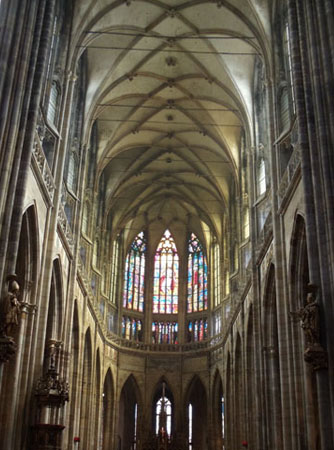
When the service ended the organist, who had had little to do during the sung mass, finally unleashed what he had evidently been waiting for: a magnificent nineteenth-century fugue that filled the cathedral. Meanwhile, the attendant quenched the candles on the altar. A few minutes later at noon, while the organist still played, the outside doors to the nave were opened. Admirers and the simply curious streamed in, cameras clicking before eyes had properly adjusted to the gloom. These visitors were consuming another example of Prague's very considerable and carefully conserved cultural capital, which they had paid good money to come to see. A great many of them were in guided tours. One efficient group was assembled behind the altar and being lectured in Japanese near the shrine to the fourteenth-century saint of the Czech Republic, John of Nepomuk, within five minutes of the mass ending. A young Czech woman, who had attended mass, was still on her knees praying devoutly before the shrine as the lecture proceeded. The press of tourists streamed around her beloved monument, creating a human traffic jam.
Participation in an ongoing tradition, involving the cathedral itself, the ritual of the mass and the congregation, had breathlessly given way to the consumption of what was now, for the tourists — and so suddenly for me — only a historic-building museum. Life had fled from this building. Inadvertently going against the press of the suddenly instituted one-way stream of human bodies, I had almost to shoulder my way through — till I got outside, into the light of day.
1 Per Wästberg, The Journey of Anders Sparrman, Granta, London, 2010, pp. 7–8; it has been translated into English by Tom Geddes. The original Swedish edition appeared in 2008.
8 David Lowenthal, The Past Is a Foreign Country, Cambridge University Press, Cambridge, 1985, p. 179.
2 See further Henry Glassie, Pattern in the Material Folk Culture of the Eastern United States, University of Pennsylvania Press, Philadelphia, 1969, pp. 26–117.
3 The instinct ought to be familiar. There is a similar reflex at work right now, also actuated by the fear of loss: the recent rapid growth in research concentration on the history of the book and print culture. A sleepy backwater of historical bibliography in Anglophone countries until the 1960s, it then received a perceptible stimulus from new quantitative French forms of study of long runs of historical data about book selling and censorship (histoire du livre). It has been accelerating independently especially since about 1990, when the end of the book began to be prophesied by ardent proponents of the capacities of the Internet.
4 Paal Mork, Norsk
Folkemuseum: The Open-Air Museum, Norskmuseum, Oslo, 2003, p. 18.
5 ibid., p. 23.
6 Vrba is described at www.nature.com/nature/journal/v156/n3968/abs/156598b0.html (accessed 9 September 2010):
Prominent among men of science in Bohemia towards the end of last century was Karel Vrba. Born at Klatovy in west Bohemia on November 10, 1845, he studied science at Prague and graduated in 1868, first becoming assistant to the professor of mineralogy, Dr. V. von Zepharovich, and later docent in petrography. Then he was appointed professor of mineralogy at Czernowitz in Bukovina, returning to Prague in the same capacity in 1881 when the Czech University was reinstated. At this time there was a complete overhauling of the old collection of minerals, to which Vrba constantly added more to make it as complete and representative as possible. He gave the first detailed descriptions (sometimes as long monographs) of twenty-nine minerals, mostly occurring locally though a few came from abroad, including one from Bolivia. The accounts of stephanite (1895) and the beryls of Pisek (1888) are regarded as Czech classics in science.
7 David Lowenthal, 'The American Way of History', Columbia University Forum, vol. 9, no. 3, Summer, 1966, 27–32 (pp. 27, 32). See also my account of Colonial Williamsburg in reCollections: 'Witnessing social history: The artefact, the visitor and the new museology', reCollections: Journal of the National Museum of Australia, vol. 3, no. 2, 2008, 101–22; also at http://recollections.nma.gov.au/issues/vol_3_no_2/papers.
9 From Kurt W Forster's discussion of Riegl (1858–1905), 'Monument/memory and the mortality of architecture', Oppositions: A Journal for Ideas and Criticism in Architecture, no. 25, Fall 1982, 2–19 (p. 15). Riegl insisted that, with historic monuments (i.e., any object with historical or artistic value, not just buildings), the 'wear and tear' should be allowed to show in order to preserve 'the signs of natural decay'. He diagnosed 'the new appreciation of monuments as the recognition of age-value'; he saw this as a reflection of a general acceptance of 'the steadily advancing death of culture' (ibid., pp. 8, 9). See also Riegl, 'The modern cult of monuments: Its character and its origin' (1903), trans. Kurt W Forster and Diane Ghirardo, Oppositions: A Journal for Ideas and Criticism in Architecture, no. 25, Fall 1982, 21–51.
10 cf. Virginia Woolf's description of the great house in Orlando (Harcourt Brace, New York, 1928, pp. 318–19), now turned into a museum:[S]he passed down the gallery whose floor was laid with oak trees sawn across. Rows of chairs with all their velvets faded stood ranged against the wall holding their arms out for Elizabeth, for James, for Shakespeare it might be, for Cecil, who never came. The sight made her gloomy. She unhooked the rope that fenced them off. She sat on the Queen's chair; she opened a manuscript book lying on Lady Betty's table; she stirred her fingers in the aged rose leaves; she brushed her short hair with King James' silver brushes; she bounced up and down upon his bed (but no King would ever sleep there again, for all Louise's new sheets) and pressed her cheek against the worn silver counterpane that lay upon it. But everywhere were little lavender bags to keep the moth out and printed notices, 'Please do not touch,' which, though she had put them there herself, seemed to rebuke her. The house was no longer hers entirely, she sighed. It belonged to time now; to history; was past the touch and control of the living ... The great wings of silence beat up and down the empty house.
